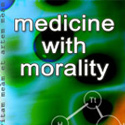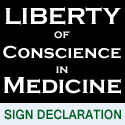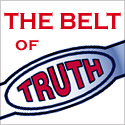Medical Ethics – Concern For Society and the Future of Medicine
Conflicting views in medical ethics.
Concern for society and the future of medicine.
At root is the conflict between the utilitarian view of human life and the ‘intrinsic value’ view (human life has intrinsic value from fertilisation to life’s natural end in all conditions of disability and dependency).
The utilitarian view is already ‘respectable’ and is dependent on the view of being human as being ‘self-aware’. It is rationalistic in its view of human life as a ‘commodity’ and relativistic in its view of sacrificing one life for the ‘greater good’ of another or the greater good of society.
Discarding of the intrinsic value view inevitably results in the following situations – each of which stand alone and require specific consideration but also inter-relate. Each of them has slippery slope ramifications. I am aware the list is ‘incomplete’ e.g. the issue of excess production of embryos for ART although this could be covered by item 6 below.
1. Creation of human life or ‘hybrid’ human life by techniques other than sperm-egg fusion and uterine implantation (ART or Assisted reproductive Technology): cloning techniques using human eggs or animal eggs; the use of animal wombs; artificial womb technology.
2. Creation of human life for destruction: for research, stem-cells, organ replacement – such destruction at the moment being arbitrarily limited to 14 days but with respectable voices calling for this to be later-stage embryos and even through to infancy or adult when required consistent with the view that they are only ‘cellular extensions’ and as that is their reason for being they are somehow of less value.
3. Creation of human life for specific purposes not necessarily involving destruction: designer babies to provide tissue matches (whether by IVF technology or by cloning), cloning for otherwise childless couples demanding their ‘right to parenthood’, cloning for special characteristics and purposes.
4. Discarding of human life by eugenic de-selection up to and including infanticide before the baby becomes self-aware – whether for reasons of diagnosed disability, or ‘imperfection’ (depending on view of society), or sex selection.
5. Discarding of human life when it is no longer ‘human’ – when it has lost self-awareness (or however ‘being human’ may subsequently be defined).
6. Discarding of human life when it becomes ‘useless’ or undesirable or a burden to self, others or society, whatever those definitions may mean to a particular society.
7. The view of human life as a commodity and the right to parenthood not just by heterosexual couples (for whatever reason) but by singles, homosexual ‘couples’, or by groups of people joining together for various purposes – the child thus produced (by any of above techniques) for various purposes that become too frightening to even imagine.
8. The commercialisation of human life (as a consequence of 7): embryos, babies, wombs, and gametes and the inevitable exploitation and abuse of females in particular that follows.
9. The direct threat to the future of medicine: that doctors must engage in the facilitation of any of the above – depending on the discipline of medicine in which they work – and that if they refuse then they should not be doctors. This has tremendous implications for medical training and will inevitably result in eliminating from specialties those that are most needed to keep that specialty at a high ethical level e.g. it will exclude all from obstetrics those with a high view of the intrinsic value of all human life – which will in turn have an effect on societal attitudes.
10. Bio-ethical economic rationalism then considers cost of disability to the community; the cost of keeping alive premature babies; cost of corrective surgery for the weak, dependent or disabled; the cost of institutionalised care; the cost of palliative care. Economic rationing necessitates examining these issues and the pressure is on to limit expense to areas that are seen to be less ‘productive’ for society. Parents who refuse eugenic de-selection for their babies are then (even now) labelled as being ‘genetic outlaws’ and the elderly, disabled and infirm are faced with the ‘duty to die’. Further implications for the doctor-patient relationship arise from the above e.g. whether the doctor is perceived as friend or foe in a particular instance or illness.
Is there any part of the above scenarios that is not foreseeable? It is now time for concerned doctors to establish an ethical framework based on moral absolutes that will be as relevant in the 22nd century as well as the 21st. It is time for concerned lawyers, concerned politicians, concerned educators to join in this.
Lachlan Dunjey. Feb 2007.






